 W
WErotic art is a broad field of the visual arts including any artistic work intended to evoke erotic arousal, usually depicting human nudity and/or sexual activity. It has included works in almost any visual medium, including drawings, engravings, films, paintings, photographs, and sculptures. Some of the earliest known works of art include erotic themes, which have recurred with varying prominence in different societies throughout history. However it has also been widely considered taboo, with either social norms or laws restricting its creation, distribution, and possession, particularly when it is deemed to be "pornographic", "immoral", or "obscene".
 W
WThe Ain Sakhri Lovers figurine is a sculpture that was found in one of the Ain Sakhri caves near Bethlehem. The sculpture is considered to be 11,000 years old and to be the oldest known representation of two people engaged in sexual intercourse.
 W
WDawn, also known as the Girl with a Lily is an oil painting by the French artist William-Adolphe Bouguereau. It was one of his most notable works. Its dimensions are 214.9 × 107 cm.
 W
WBaemikkumi Sculpture Park is a sculpture park rest at the southern part of the Modo Island, which is one of the nearest islets to Yeongjongdo Island in South Korea. The park contains around hundred modern and abstract surrealistic sculptures are displayed on the theme of eroticism. The park's collection of large-scale works by sculptor Lee Il-Ho, many of which sit conspicuously along the beach.
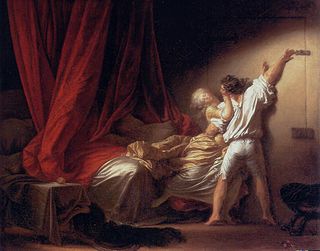 W
WThe Bolt, also known as The Lock, is a gallant scene painted by Jean-Honoré Fragonard in 1777. It is one of the most famous paintings by the painter. The common interpretation suggests that the scene depicts two lovers entwined in a bedroom, the man locking the door. The painting is preserved in the Louvre Museum, in the section of the Department of Paintings devoted to eighteenth-century French painting on the second floor of the Sully wing. It stands together with some of the most famous pictorial masterpieces of the same period, in a chronologically organized path. This painting, a true symbol of the libertine spirit of the 18th century, reflects the state of mind adopted by the painters of the era, notably that of François Boucher, one of Fragonard's teachers and a great representative of rococo painting.
 W
WThe Breakdown was a 1926 painting by Scottish artist John Bulloch Souter (1890–1972) which stirred controversy in the United Kingdom during the Jazz Age. The work depicted a black jazz musician playing the saxophone while a naked white woman dances, as if in a trance.
 W
WClop is a slang term for fan-made pornography or erotic art based on the animated children's television series My Little Pony: Friendship is Magic and can be viewed either as a subset of brony fandom, furry fandom, or both.
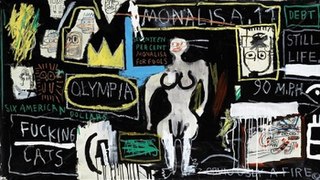 W
WCrown Hotel is a painting created by American artist Jean-Michel Basquiat in 1982. The artwork cites Leonardo da Vinci's Mona Lisa and Édouard Manet's Olympia, two canonical works of western art. In June 2013, it sold for $7.4 million at Sotheby’s.
 W
WFetish art is art that depicts people in fetishistic situations such as S&M, domination/submission, bondage, transvestism and the like, sometimes in combination. It may simply depict a person dressed in fetish clothing, which could include undergarments, stockings, high heels, corsets, or boots. A common fetish theme is a woman dressed as a dominatrix.
 W
WThe Great Masturbator (1929) is a painting by Salvador Dalí executed during the surrealist epoch, and is currently displayed at Museo Nacional Centro de Arte Reina Sofía, Madrid.
 W
WHatstand, Table and Chair are a group of three erotic sculptures by British pop artist Allen Jones, created in 1969 and first exhibited in 1970. They have been described in retrospect as "emblematic of the spirit of the 1960s" and an "international sensation." At the time they were met with angry protests, particularly from feminists who saw them as an objectification of women.
 W
WThe history of erotic depictions includes paintings, sculpture, photographs, dramatic arts, music and writings that show scenes of a sexual nature throughout time. They have been created by nearly every civilization, ancient and modern. Early cultures often associated the sexual act with supernatural forces and thus their religion is intertwined with such depictions. In Asian countries such as India, Nepal, Sri Lanka, Japan and China, representations of sex and erotic art have specific spiritual meanings within native religions. The ancient Greeks and Romans produced much art and decoration of an erotic nature, much of it integrated with their religious beliefs and cultural practices.
 W
WJoseph and Potiphar's Wife is a 1634 etching by Rembrandt. It depicts a story from the Bible, wherein Potiphar's Wife attempts to seduce Joseph. It is signed and dated "Rembrandt f. 1634", and exists in two states.
 W
WThe Khajuraho Group of Monuments are a group of Hindu and Jain temples in Chhatarpur district, Madhya Pradesh, India, about 175 kilometres southeast of Jhansi. They are a UNESCO World Heritage Site. The temples are famous for their nagara-style architectural symbolism and their erotic sculptures.
 W
WKrishna and Radha in a Pavilion is an 18th-century Indian painting depicting the two Hindu deities Krishna and Radha engaged in sexual intercourse.
 W
WLove Land would have been the first sex theme park in China; the PRC Government suspended its construction in Chongqing in May 2009 and ordered it demolished for being vulgar and explicit. The park was to include displays of giant genitalia and naked bodies, and host an exhibition on the history of human sexuality along with sex technique workshops. The closure is a reflection of the conservatism with regard to sex in China.
 W
WJeju Loveland (제주러브랜드) is an outdoor sculpture park which opened in 2004 on Jeju Island in South Korea. The park is focused on a theme of sex, running sex education films, and featuring 140 sculptures representing humans in various sexual positions. It also has other elements such as large phallus statues, stone labia, and hands-on exhibits such as a "masturbation-cycle". The park's website describes the location as "a place where love oriented art and eroticism meet".
 W
WThe Lovers, Two Lovers or Love Scene is an oil painting by Giulio Romano, originally painted on panel and later transferred to canvas by A Mitrokin in 1834. Since it was poorly stored and kept off public display due to its subject matter until 1920, it has significant damage, including three large breaks in the canvas sealed with coarse plasters on the reverse and other damage to the paint and varnish layer both before and after the transfer It now hangs in the Hermitage Museum.
 W
WThe Nude Maja is a name given to a c. 1797–1800 oil on canvas painting by the Spanish artist Francisco Goya. It portrays a nude woman reclining on a bed of pillows, and was probably commissioned by Manuel de Godoy, to hang in his private collection in a separate cabinet reserved for nude paintings. Goya created a pendant of the same woman identically posed, but clothed, known today as La maja vestida ; also in the Prado, it is usually hung next to La maja desnuda. The subject is identified as a maja based on her costume in La maja vestida.
 W
WI Modi, also known as The Sixteen Pleasures or under the Latin title De omnibus Veneris Schematibus, is a famous erotic book of the Italian Renaissance in which a series of sexual positions were explicitly depicted in engravings. While the original edition was apparently completely destroyed by the Catholic Church, fragments of a later edition survived. The second edition was accompanied by sonnets written by Pietro Aretino, which described the sexual acts depicted. The original illustrations were probably copied by Agostino Carracci, whose version survives.
 W
WOlympia is a painting by Édouard Manet, first exhibited at the 1865 Paris Salon, which shows a nude woman ("Olympia") lying on a bed being brought flowers by a servant. Olympia was modelled by Victorine Meurent and Olympia's servant by the art model Laure. Olympia's confrontational gaze caused shock and astonishment when the painting was first exhibited because a number of details in the picture identified her as a prostitute. The French government acquired the painting in 1890 after a public subscription organized by Claude Monet. The painting is on display at the Musée d'Orsay, Paris.
 W
WThe Oreads is an oil painting by the French artist William-Adolphe Bouguereau, painted in 1902. Its dimensions are 236 × 182 cm.
 W
WL'Origine du monde is a picture painted in oil on canvas by the French artist Gustave Courbet in 1866. It is a close-up view of the genitals and abdomen of a naked woman, lying on a bed with legs spread.
 W
WThe Pearl and the Wave, also known as The Wave and the Pearl, is a painting by the French artist Paul-Jacques-Aimé Baudry created in 1862. The painting shows a nude woman lying on the edge of a rocky sea shore, with her head turned to gaze backward over her shoulder towards the viewer. Waves are breaking in the background.
 W
WPortrait of Ms Ruby May, Standing is an oil on canvas painting made in 2012 by the British visual artist Leena McCall, portraying her friend Ruby May.
 W
WThe Rokeby Venus is a painting by Diego Velázquez, the leading artist of the Spanish Golden Age. Completed between 1647 and 1651, and probably painted during the artist's visit to Italy, the work depicts the goddess Venus in a sensual pose, lying on a bed and looking into a mirror held by the Roman god of physical love, her son Cupid. The painting is in the National Gallery, London.
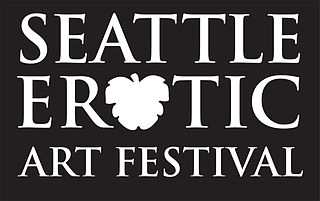 W
WSeattle Erotic Art Festival was founded in 2002 by the Center for Sex Positive Culture. It is now the flagship program of the nonprofit Foundation for Sex Positive Culture.
 W
WSlave Market in Ancient Rome is a painting of about 1884 by French artist Jean-Léon Gérôme, who was known for combining classical, romantic, and realistic elements. It depicts an Ancient Roman slave auction in progress. At the center of a high dais is a completely nude women having been recently undressed by the slave dealer situated to her right, who is displaying her to the crowd as they bid on her. The woman shields her eyes with her right hand due to the humiliating predicament of being publicly exposed in front of such a large crowd. Another nude young woman sits fearfully at the first woman's feet, covering her breasts with her legs in a protective pose, however, this leaves her genitals exposed to the crowd. Behind her is an older clothed woman holding an infant, she is surrounded by two naked children who she is probably the mother of. Her face has a look of dread as she knows she is to be auctioned soon, most likely being separated from her children forever. Behind the auction booth, two men are keeping an account of the sales, with a row of enslaved men looking on from behind them. It is one of his six slave-market scenes set in either ancient Rome or 19th-century Istanbul that Gérôme painted during his career.
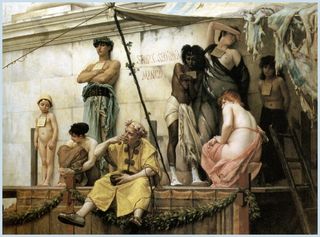 W
WThe Slave Market is a painting first exhibited at the Paris Salon of 1886 by the French artist Gustave Boulanger, who specialized in classical and Orientalist genre scenes. Its title in the Salon catalogue was Un Maquignon d’esclaves à Rome, but as early as 1888 it was called Vente d’escalves in the French press, and in English it has become known as The Slave Market. It is sometimes compared to or confused with various paintings of slave markets in the Arab world and the ancient world by Boulanger's friend and fellow painter Jean-Léon Gérôme.
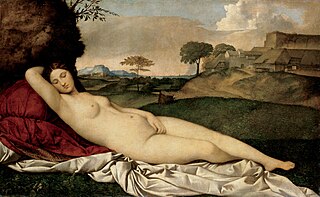 W
WThe Sleeping Venus, also known as the Dresden Venus, is a painting traditionally attributed to the Italian Renaissance painter Giorgione, although it has long been usually thought that Titian completed it after Giorgione's death in 1510. The landscape and sky are generally accepted to be mainly by him. In the 21st century, much scholarly opinion has shifted further, to see the nude figure of Venus as also painted by Titian, leaving Giorgione's contribution uncertain. It is in the Gemäldegalerie, Dresden. After World War II, the painting was briefly in possession of the Soviet Union.
 W
WLe Sommeil is an erotic oil painting on canvas by French artist Gustave Courbet created in 1866. The painting, which depicts a lesbian couple, is also known as the Two Friends and Indolence and Lust.
 W
WThe State Bed is a 1646 print by Rembrandt in etching and drypoint. It is also known as Le Lit à la française, a title first given to it in Edme-François Gersaint's 1751 Catalogue raisonné de toutes les pièces qui forment l’œuvre de Rembrandt.
 W
WStay Up Late is a 1992 erotic furry watercolor painting by Brian Swords. It depicts two anthropomorphic rats embracing. The painting gained prominence when John Oliver offered to buy the painting in the 29 March 2020 episode of Last Week Tonight with John Oliver.
 W
WThe Swing, also known as The Happy Accidents of the Swing, is an 18th-century oil painting by Jean-Honoré Fragonard in the Wallace Collection in London. It is considered to be one of the masterpieces of the Rococo era, and is Fragonard's best known work.
 W
WThe Lovers, alternatively titled Two Lovers or Courtly Lovers, is an early 17th-century painting by Iranian artist Reza Abbasi. Done in a combination of ink, watercolor, and gilding on paper, the work depicts a couple of lovers embracing each-other. The painting is in the collection of the Metropolitan Museum of Art.
 W
WVenus of Poetry is an oil painting by the Spanish artist Julio Romero de Torres, painted in 1913, and now exhibited at the Bilbao Fine Arts Museum. Its dimensions are 93.2 × 154 cm.
 W
WThe Venus of Urbino is an oil painting by the Italian painter Titian, which seems to have been begun in 1532 or 1534, and was perhaps completed in 1534, but not sold until 1538. It depicts a nude young woman, traditionally identified with the goddess Venus, reclining on a couch or bed in the sumptuous surroundings of a Renaissance palace. It is now in the Galleria degli Uffizi in Florence.
 W
W